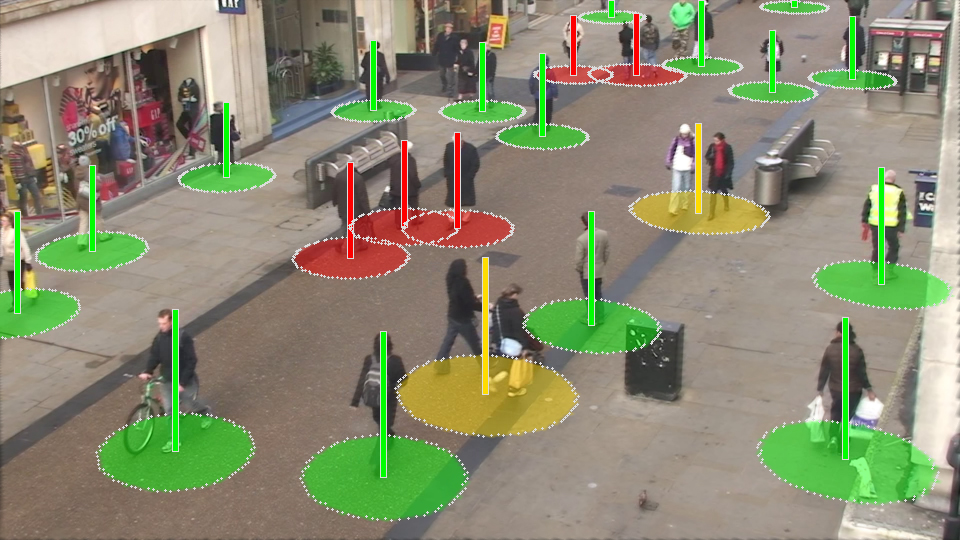Social Distancing is a new terminology that became a popular term since mid-2020, after a global hit and pandemic by the new generation of the coronavirus (COVID-19).
Social distancing is the act of maintaining a safe distance (equal to 6 feet or 2 meters) between individuals as a recommended solution by the World Health Organisation (WHO) to minimise the spread of COVID-19 in public places.
By the end of 2020, the majority of governments and national health authorities have set the 2-meter physical distancing as a mandatory measure in shopping centres, schools, pubs, restaurants, and public places.
- Social Distancing
- COVID-19
- Human Detection
- People Detection
- Tracking
- Distance Estimation
- Convolutional Neural Networks

Social distancing, as shown in Figure 1.a [1] refers to precaution actions to prevent the proliferation of the disease, by minimising the proximity of human physical contacts in crowded public places (e.g. schools, workplaces, gyms, lecture theatres, pubs, restaurants) to stop the widespread accumulation of the infection risk (Figure 1.b) [1].
Figure 2 demonstrates the effect of following appropriate social distancing guidelines to reduce the rate of infection transmission among individuals [2][3]. A wider Gaussian curve with a shorter spike within the range of the health system service capacity makes it easier for patients to fight the virus by receiving continuous and timely support from the health care organisations. Any unexpected sharp spike and rapid infection rate (such as the red curve in Figure 2), will lead to a service failure, and consequently, exponential growth in the number of fatalities.

During the COVID-19 pandemic, governments have tried to implement a variety of social distancing practices, such as restricting travels, controlling borders, closing pubs and bars, and alerting the society to maintain a distance of 1.6 to 2 m from each other [4]. However, monitoring the amount of infection spread and efficiency of the constraints is not an easy task. People require to go out for essential needs such as food, health care and other necessary tasks and jobs. Therefore, many other technology-based solutions such as [5][6] and AI-related research such as [7][8][9] have tried to step in to help the health and medical community in copping with COVID-19 challenges and successful social distancing practices. These works vary from GPS-based patient localisation and tracking to segmentation, and crowd monitoring.
Video 1: DeepSOCIAL by Rezaei and Azarmi. Reference [1]
Video 1 from [1] demonstrates the important role of Computer Vision and Artificial Intelligence in facilitating social distancing monitoring. The research shows how deep neural networks enable us to extract complex features from the image data so that we reach very accurate information about the people behaviour and distances. Possible challenges in this area are the importance of gaining a high level of accuracy, dealing with a variety of lighting conditions, occlusion, and real-time performance. As one of the most comprehensive works done so far, the research [1] aims at providing solutions to cope with the mentioned challenges. We have summarised and highlighted the main contribution of this research as follows:
• This study aims to support the reduction of the coronavirus spread and its economic costs by providing an AI-based solution to automatically monitor and detect violations of social distancing among individuals.
• The research develops a robust deep neural network (DNN) model for people detection, tracking, and distance estimation called DeepSOCIAL with more accurate results comparing to earlier research such as in [9]
• The study performs a live and dynamic risk assessment, by statistical analysis of Spatio-temporal data from the people movements at the scene. Their method tracks the moving trajectory of people and their behaviours, to analyse the ratio of the social distancing violations to the total number of people in the scene, and detects high-risk zones for short- and long-term periods.
• The validity of the experimental results has been supported by performing extensive tests and assessments in a diversity of indoor and outdoor datasets which outperform the state-of-the-art.
• The proposed model can perform as a generic human detection and tracker system, not limited to social-distancing monitoring, and it can be applied for various real-world applications such as pedestrian detection in autonomous vehicles, human action recognition, anomaly detection, and security systems.
References
- Rezaei, Mahdi; Azarmi, mohsen; DeepSOCIAL: Social Distancing Monitoring and Infection Risk Assessment in COVID-19 Pandemic. Applied Sciences 2020, 1, 1-30.
- Min W. Fong; Huizhi Gao; Jessica Y. Wong; Jingyi Xiao; Eunice Y.C. Shiu; Sukhyun Ryu; Benjamin J. Cowling; Nonpharmaceutical Measures for Pandemic Influenza in Nonhealthcare Settings—Social Distancing Measures. Emerging Infectious Diseases 2020, 26, 976-984, 10.3201/eid2605.190995.
- Faruque Ahmed; Nicole Zviedrite; Amra Uzicanin; Effectiveness of workplace social distancing measures in reducing influenza transmission: a systematic review. BMC Public Health 2018, 18, 1-13, 10.1186/s12889-018-5446-1.
- Gareth Iacobucci; Covid-19: Lack of capacity led to halting of community testing in March, admits deputy chief medical officer. BMJ 2020, 369, m1845, 10.1136/bmj.m1845.
- Cong T. Nguyen; Yuris Mulya Saputra; Nguyen Van Huynh; Ngoc-Tan Nguyen; Tran Viet Khoa; Bui Minh Tuan; Diep N. Nguyen; Dinh Thai Hoang; Thang X. Vu; Eryk Dutkiewicz; et al.Symeon ChatzinotasBjoörn Ottersten A Comprehensive Survey of Enabling and Emerging Technologies for Social Distancing — Part I: Fundamentals and Enabling Technologies. IEEE Access 2020, 1, 1-1, 10.1109/access.2020.3018140.
- Narinder Singh Punn; Sanjay Kumar Sonbhadra; Sonali Agarwal; COVID-19 Epidemic Analysis using Machine Learning and Deep Learning Algorithms. null 2020, 2, 1-10, 10.1101/2020.04.08.20057679.
- Feng Shi; Jun Wang; Jun Shi; Ziyan Wu; Qian Wang; Zhenyu Tang; Kelei He; Yinghuan Shi; Dinggang Shen; Review of Artificial Intelligence Techniques in Imaging Data Acquisition, Segmentation and Diagnosis for COVID-19. IEEE Reviews in Biomedical Engineering 2020, 1, 1-1, 10.1109/rbme.2020.2987975.
- Rajan Gupta; Gaurav Pandey; Poonam Chaudhary; Saibal K. Pal; Machine Learning Models for Government to Predict COVID-19 Outbreak. Digital Government: Research and Practice 2020, 1, 1-6, 10.1145/3411761.
- Narinder Singh Punn; Sanjay Kumar Sonbhadra; Sonali Agarwal; Monitoring COVID-19 social distancing with person detection and tracking via fine-tuned YOLO v3 and Deepsort techniques. null 2020, 1, 12-24.

